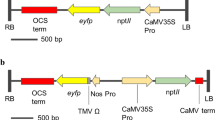Abstract
Glyphosate resistant crops are useful to agriculture by facilitating the use of nonselective herbicides, such as RoundUp®, that have low human and environmental toxicity. The occurrence of glyphosate resistant weeds, however, has raised concern about the future utility of these crops. Conyza canadensis (L.) Cronquist (marestail or horseweed) is one such glyphosate resistant weed that has yet to be fully analyzed or established in tissue culture. Tissue culture enables the examination of physiological characteristics of a plant in an aseptic and controlled environment. For the present study, mairstail was cultured on a Murashige and Skoog based medium supplemented with 6-benzylaminopurine, and α-naphthaleneacetic acid. Plant regeneration was achieved on the same basal medium supplemented with only gibberellic acid. Glyphosate resistance could be demonstrated in the cultured tissues. The cultures could also be transformed with Agrobacterium tumefaciens without chemically inducing virulence using phenolics or glucose and resulting in a transformation frequency (transgenic events per total number of explants used) of about 13%. The tissue culture growth, preliminary glyphosate resistance data and genetic transformation data gathered in this project provide the means to further evaluate the mode of glyphosate resistance expressed by marestail.






Similar content being viewed by others
Abbreviations
- BA :
-
6-benzylaminopurine
- EPSPS :
-
5-enolpyruvylshikimate-3-phosphate synthase
- GA 3 :
-
gibberellic acid
- GFP :
-
green fluorescent protein
- gfw :
-
gram fresh weight
- HPLC :
-
high performance liquid chromatography
- NAA :
-
α-naphthaleneacetic acid
- PEP :
-
phosphoenolpyruvate
- OD :
-
optical density
- UV :
-
ultraviolet
References
Baerson SR, Rodriguez DJ, Tran M, Feng Y, Biest NA, Dill GM (2002) Glyphosate resistant goosegrass. Identification of a mutation in the target enzyme 5 enolpyruvylshikimate-3-phosphate synthase. Plant Physiol 129:1265–1275
Beckie HJ, Heap IM, Smeda RJ, Hall LM (2000) Screening for herbicide resistance in weeds. Weed Technol 14:428–445
Dyer WE (1994) Resistance to glyphosate. In: Powles SB, Holtrum JAM (eds) Herbicide resistance in plants, biology and biochemistry. Lewis Publishers, Boca Raton, FL, pp 229–241
Estelle M (1998) Polar auxin transport: new support for an old model. Plant Cell 10:1775–1778
Gamborg OL, Miller BA, Ojima K (1968) Nutrient requirements of suspension cultures of soybean root cells. Exp Cell Res 50:151–158
Lee LJ, Ngim J (2000) A first report of glyphosate-resistant goosegrass (Eleusine indica (L.) Gaertn) in Malaysia. Pest Manage Sci 56:336–339
Mulugeta D, Boerboom CM (1999) Critical time of weed removal in glyphosate-resistant Glycine max. Weed Sci 48:35–42
Murashige T, Skoog F (1962) A revised medium for rapid growth and bioassays with tobacco tissue cultures. Physiol Plant 15:473–497
Pline WA, Edmisten KL, Wilcut JW, Wells R, Thomas J (2003) Glyphosate-induced reductions in pollen viability and seed set in glyphosate-resistant cotton and attempted remediation by gibberellic acid (GA3). Weed Sci 51:19–27
Powles SB, Lorraine-Colwill DF, Dellow JJ, Preston C (1998) Evolved resistance to glyphosate in rigid ryegrass (Lolium rigidum) in Australia. Weed Sci 46:604–607
Simarmata M, Kaufmann JE, Penner D (2003) Potential basis of glyphosate resistance in California rigid ryegrass (Lolium rigidum). Weed Sci 51:678–682
VanGessel MJ (2001) Glyphosate-resistant horseweed from Delaware. Weed Sci 49:703–705
Wang C (2001) Effect of glyphosate on aromatic amino acid metabolism in purple Nutsedge (Cyperus rotundus). Weed Technol 15:628–635
Wang J, Seliskar DM, Gallagher JL (2003) Tissue culture and plant regeneration of Spartine alterniflora: implications for wetland restoration. Wetlands 23:386–393
Acknowledgments
Thanks to Gregory Heck of Monsanto Co. for supplying seed of both resistant and susceptible marestail. This work was funded in part by USDA Grant #00-38422-9.169
Author information
Authors and Affiliations
Corresponding author
Additional information
Communicated by M. E. Horn
Rights and permissions
About this article
Cite this article
Scheiber, P.A., Tran, M. & Duncan, D.R. Tissue culture and transient transformation of Marestail (Conyza canadensis (L.) Cronquist). Plant Cell Rep 25, 507–512 (2006). https://doi.org/10.1007/s00299-005-0104-3
Received:
Revised:
Accepted:
Published:
Issue Date:
DOI: https://doi.org/10.1007/s00299-005-0104-3




